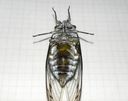Giant Cicada
Quesada gigas
Classification
- Phylum: Arthropoda
- Subphylum: Hexapoda
- Class: Insecta
- Order: Hemiptera
- Suborder: Auchenorrhyncha
- Infraorder: Cicadomorpha
- Superfamily: Cicadoidea
- Family: Cicadidae
- Subfamily: Cicadinae
- Tribe: Fidicini
- Genus: Quesada
- Species: gigas
Pronunciation
How to pronounce Quesada gigas: /kweˈsaːda ˈɡiːɡas/
These audio files are automatically generated. While they are not always 100% accurate, they are a good starting point.
Images






Summary
Quesada gigas, the giant cicada, is the widest-ranging cicada in the Western Hemisphere, known for its loud song and unique feeding habits on tree roots.
Physical Characteristics
The giant cicada has a combination of black, green, and brown patterns on its body, with brown to olive eyes and a brownish-green pronotal collar.
Identification Tips
Distinguished by its loud song rather than appearance. It is the second-largest North American cicada species, after the empress cicada.
Habitat
Primarily resides in the South Texas brushland and various environments throughout its range.
Distribution
Ranges from central Texas to as far south as Mina Clavero, Argentina. Found in much of North, Central, and South America.
Diet
Feeds on the roots of trees, primarily Huisache and other members of the legume family.
Life Cycle
Immature cicadas spend at least four years underground before emerging as adults.
Reproduction
Generally, cicadas emerge from their underground phase and reproduce during the warmer months, with emergence typically occurring from April to October in South Texas and June to July in Central Texas.
Ecosystem Role
Plays a significant role in the ecosystem as a herbivore, affecting plant communities through its feeding habits.
Cultural Significance
Known for its distinctive and loud song, contributing to the natural soundscape in its habitat.
Evolution
Part of the taxonomic family Cicadidae, with historical records dating back to its original description by Olivier in 1790.
Misconceptions
Often confused with other cicada species due to its size and sound, but is distinctive in its loudness and range.
Tags
- Cicada
- Insect
- Hearing
- Giant Cicada
- Ecosystem